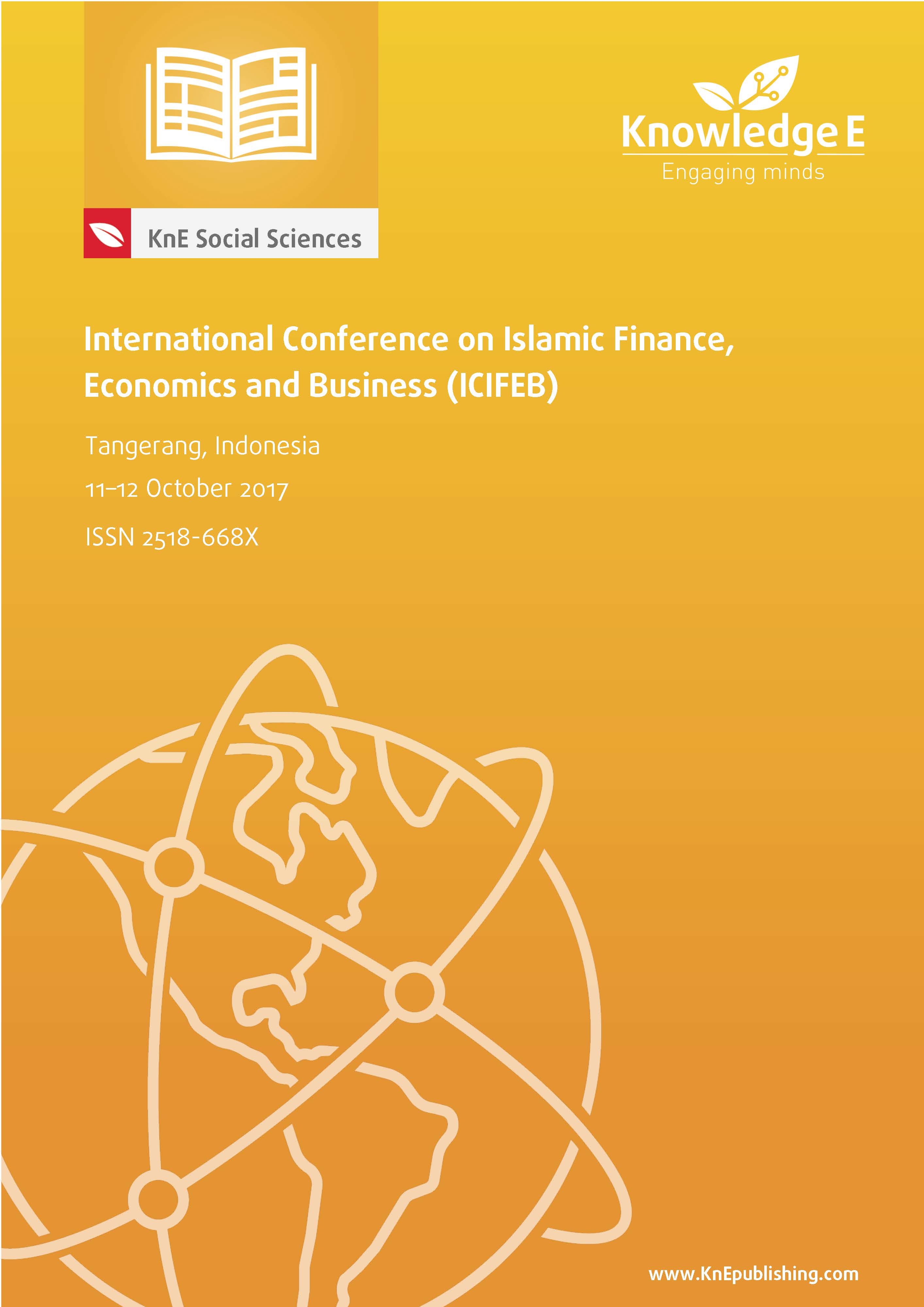Vulnerability of Islamic Financial Institutions in a Financial Crisis
DOI:
https://doi.org/10.18502/kss.v3i8.2502Abstract
This article examines the risks that the Islamic Banking industry may be exposed to in a financial crisis. In order to set the context, it first discusses the sources of bank finance in both the conventional banking industry and Islamic banking. It then examines the various types of risk exposure by conventional banks and Islamic banks. It analyses the types of problems which are unique to Islamic banking in contrast to conventional banking. It then considers what lessons can be learned from the global financial crisis, particularly for Islamic banking. This article argues that in order to ensure stability for Indonesian Islamic Financial Institutions, banks must address each of the identified risks. It points to recent illustrations of institutional failure because of failure to address the risk.
Keywords: Islamic Financial Institutions, financial crisis, vulnerability, risks
References
Ahmad, N. (2008). Basel II Capital Adequacy Requirements: Implementation Challenges for Islamic Banks. 6th International Islamic Finance Conference 2008 Peer Reviewed Paper, IIU Malaysia
Akin, T., Iqbal, Z., & Mirakhor, A. (2016). The composite risk-sharing finance index: Implications for Islamic finance. Review of Financial Economics, 31, 18-25. doi: http://dx.doi.org/10.1016/j.rfe.2016.06.001
Alawode, AA. (2015, March 31). The World Bank group is working with Islamic finance to reduce poverty, expand access to finance, develop the financial sector, and build financial sector stability and resilience in client countries. THE WORLD BANK. Retrieved from http://www.worldbank.org/en/topic/financialsector/brief/ islamic-finance
Amianti, GD (2016, January 13), BI’s new capital buffer ruling positive for banks, the Jakarta post, Retrieved from http://www.thejakartapost.com/news/2016/01/ 13/bi-s-new-capital-buffer-ruling-positive-banks.html
Bank for International and Settlements, (2009) Enhancements to the Basel II framework. Retrieved from http://www.bis.org/publ/bcbs157.pdf
Bank for International and Settlements, (2013) Basel III: The Liquidity Coverage Ratio and liquidity risk monitoring tools. Retrieved from http://www.bis.org/publ/ bcbs238.htm
Bank for International Settlements, (2011) Basel III: International regulatory framework for banks. Retrieved from http://www.bis.org/bcbs/basel3.htm?m= 3%7C14%7C572
Basel Committee on Bank Supervision, (2016, April) Standards interest rate risk in the banking book, Bank for International Settlements (BASEL). Retrieved from http: //www.bis.org/bcbs/publ/d368.pdf
Caruana, J. (2010) Systemic risk: how to deal with it? Bank for International Settlements. Retrieved from http://www.bis.org/publ/othp08.htm
Chen, N. F., Roll, R., & Ross, S. (1986). Economic forces and the stock market. Journal of Business, 59(3), 383-403. doi: http://dx.doi.org/10.1086/296344
Chong, Beng Soon, Ming-Hua Lin. (2006). Islamic banking: interest-free or interest- based? Available at http//ssrn.com/-abstract=868567.
Editor ACKS. (2016, January 14). Sumber dana bank syariah. Pasar Modal Syariah. Retrieved from http://akucintakeuangansyariah.com/ sumber-dana-bank-syariah/
Errico, L. and Farrahbaksh, M. (1998) Islamic banking: Issues in prudential regulation and supervision, IMF Working Paper No. 98/30.
Festiani, S. (2015, April 30). Perbankan Syariah Kekurangan SDM. Republika, Retreived from http://www.republika.co.id/berita/ekonomi/syariah-ekonomi/15/ 04/30/nnlvn3-perbankan-syariah kekur1angan-sdm
Fitch Ratings (2016, November 30). Fitch: Tougher Operating Environment Chal- lenges Saudi Islamic Banks. Retrieved from https://www.fitchratings.com/site/pr/ 1015535
Fitch Ratings (2017a, August 09). Fitch: UAE Islamic banks affected by higher financing costs and impairment charges. Retrieved from https://www.fitchratings. com/site/pr/1027609
Fitch Ratings (2017b, June 21). Fitch places 9 Qatari banks on rating watch negative. Retrieved from https://www.fitchratings.com/site/pr/1025444
Gait, A.H., & Worthington, A.C. (2007) A Primer on Islamic Finance: Definitions, Sources, Principles and Methods, University of Wollongong Australia, School of Accounting and Finance Working Paper Series No. 07/05
Ghandour, G.F. (2017). The importance of a capital adequacy for Islamic banks. International Journal of Research Granthaalayah, 5(4), 292-300. doi: https://doi.org/ 10.5281/zenodo.573000.
Global business guide Indonesia (2016), Indonesia’s Islamic banking industry: bright prospects ahead despite constraints. Retrieved from http://www.gbgindonesia. com/en/finance/article/2016/indonesia_s_islamic_banking_industry_bright_ prospects_ahead_despite_constraints_11516.php
Gupta, R. D., & Modise, M. P. (2013). Macroeconomic Variables and South African Stock Return Predictability. Economic Modelling, 30, 612-622. doi: http://dx.doi.org/ 10.1016/j.econmod.2012.10.015
Habibi, N. (2009, December) The impact of the global economic crisis on Arab countries: a year-end assessment, Crown Center for Middle East Studies, Brandeis University, Massachusetts, No. 40
International Monetary Fund. (2017, February 21). Insuring financial stability in countries with Islamic banking. Retrieved from http: //www.imf.org/en/Publications/Policy-Papers/Issues/2017/02/21/ PP-Ensuring Financial-Stability-in-Countries-with-Islamic-Banking
Khan, T. and Ahmed, H. (2001) Risk management: An analysis of issues in Islamic financial industry, Occasional Paper No. 5, IRTI, Islamic Development Bank, Jeddah.
Makhijani, D.N.K. (2011, September). Produk Bank syariah: jangan kau ragukan lagi. Gerai Info Newsletter Bank Indonesia. Retrieved from: http://www.bi.go.id/ id/publikasi/gerai info/Documents/90336e37b2c040f3952a1105495799fbGIed18_ sep2011_low.pdf
Medita, A (2017, February 10). Skandal Bank Muamalat (1): CEO lemah, Bank Muamalat ’rontok’?. VOAIslam, Retreived from http://www/voa-islam.com
Mia, M R., Hasnat, M A., & Majabeen, W. (2016). Mudharabah and Musharakah from the accounting perspective. IOSR Journal of Business and Management, 18(7), 67- 72. Retreived from http://www.iosrjournals.org/iosr-jbm/papers/Vol18-issue7/ Version-3/J1807036772.pdf Obaidullah, M. (2005) Islamic financial services, Islamic Economics Research Center, King Abdulaziz University, Jeddah, Saudi Arabia.
Perbankan. (2015, May 05). Sumber dana pada bank syariah. Syariah Bank. Retrieved from http://www.syariahbank.com/ sumber-dana-pada-bank-syariah-part-iii/
Rahmah, G. (2015, November 22). Ini 7 Masalah Bank Syariah. Tempo. Retrieved from https://m.tempo.co/read/news/2015/11/22/087721104/ ini-7-masalah-bank-syariah
Reserve Bank of Australia. (2015). Box A: the Basel III liquidity reforms in Australia. Retrieved from: http://www.rba.gov.au/publications/fsr/2015/mar/box-a.html
Sundararajan, V. and Errico, L. (2002) Islamic financial institutions and products in the global financial system: Key issues in risk management and challenges ahead, IMF Working Paper No. WP/02/192, Washington D.C., I.M.F.
Syafi’i Antonio, Muhammad (2001). Bank Syariah, Dari Teori ke Praktik, penyunting Dadi M.H. Basri, Farida R. Dewi, Cet. 1, Jakarta: Gema Insani Press. ISBN 979-561- 688-9.
Syed, A. A. S. G., & Shaikh, F. M. (2011). Islamic finance system shields against financial crisis. Pakistan & Gulf Economist, 30(35), 30-32. Retrieved from https:// search-proquest com.ezproxy.uws.edu.au/docview/1023123682?accountid=3615
Todaydubai. (2009, November 28). Dubai World Debt Crisis: Is Dubai bankrupt? Retrieved from http://www.2daydubai.com/pages/dubai-world-crisis.php#1

